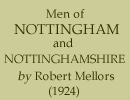< Previous | Contents | Next >
BARBER WALKER & COMPANY, Colliery Proprietors, Eastwood and elsewhere.
THOMAS BARBER, (1805-1874), who was head of the firm, was born at Lamb Close House, in the parish of Greasley, Nottinghamshire, and educated at Eton and Trinity College, Cambridge. He afterwards became a barrister, but never practised, for he loved a quiet life, and took no part in public affairs. A man of deep religious convictions, he generously supported all the churches and chapels in the neighbourhood, and did much in helping the workpeople of the firm in cases of sickness and distress. Under his will, his interests in the collieries became the property of his eldest son.
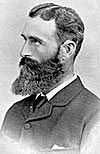
Thomas Barber.
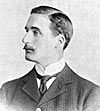
Thomas P. Barber.
THOMAS BARBER, (1843-1893), who was also generous in supporting all good works in the neighbourhood. He built, at a cost of about £3,000, an Institute at Underwood for the firm's workpeople, which was opened shortly after his death. Major T. P. Barber, D.S.O., J.P., is the son of this gentleman.
A pleasing memorial of the regard in which Thomas Barber the elder was held was shown recently by the handing over to the Nottingham General Hospital of a fund for the endowment of a bed, called "The Barber Memorial Bed," the inscription on which states that the funds were subscribed by Messrs. Barber Walker & Co., Limited, and their employees, and others, in memory of Thomas Barber; and another fund was handed over for "The Barber Walker Employees Memorial Bed," which was originally intended to be applied towards the erection of a Hospital at Eastwood. The funds together amounted to £2,689 18s. 0d.
Let us turn from the individual partners to the firm, now become a Limited Company; for it supplies an illustration of the advantages to be derived from the mutual co-operation of brains and capital and labour, resulting in confidence, development, steady employment, and benefit to the public, as well as to the parties immediately concerned. In 1700 Barber & Company's Collieries were at Eastwood and Langley Mill. In 1791 we are told by Throsby that coals were "found here at the depths of five yards and fifty," and he states that at Bilborough, which was then unenclosed, there were considerable coal works "leased to a Mr. Walker and a Mr. Barber," and the coals were got at one hundred yards deep.
In 1800 the firm was known as Barber Walker & Co. The canal was helpful to their enterprise, but they and other colliery proprietors in the Erewash Valley, wanted to get better access to Leicestershire, and in 1832, at a meeting held at "The Sun Inn," at Eastwood, a subscription was entered into for the promotion of an Erewash Valley Railway, at which £32,000 was subscribed, £10,000 of it being promised by Barber Walker & Co. (Mid. Rly. by F. S. Williams, p. 9).
There is not space here to pursue the subsequent developments of the firm. The Company has at the present time five collieries situate in the locality of Eastwood, and also a colliery at Bentley, near Doncaster, which was sunk about twenty years ago. They also own the Harworth Colliery in North Nottinghamshire, the coalfield of which is nearly 20,000 acres in extent, situate in the parishes of Harworth, Styrrup, Blyth, Hodsock, Scrooby, Ranskill, Torworth, Barnby Moor, and Scaftworth in Nottinghamshire., and in the parishes of Austerfield, Bawtry, and Tickhill in the West Riding of York. At the time of writing, (March 1924) the company are engaged in completing the sinking of two shafts near Harworth, where the Barnsley seam—which they intend to work—was in October last reached at a depth of about 930 yards. Land has been acquired in the parish of Harworth for a colliery village, for which water works have been constructed.
The Company now employs over 7,000 workpeople at their various collieries, and when the Harworth Colliery is fully going that number will be increased by 3,500 at least.
It would be impossible for such a concern to be worked without not only willing hands, but also by the faithful men who have had the actual management. In this respect the firm has been very fortunate, but the number of them is such that they cannot even be named here. The last to go may be mentioned as a specimen: Alfred W. Brentnall, who died in February, 1924, aged ninety, had been from boyhood in the employ of the firm, as was his father before him for forty years, and when the father died the son succeeded to his office, and both of them were active in promoting the welfare of the people.
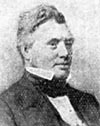
THOMAS BAYLEY, (d. 1874), was a Tanner and Leather dresser at Lenton, where the business was established by his father, Isaac Bayley, on a very small scale, but became so extended that 450 to 500 workpeople were employed, there being other works at Newark, Giltbrook, etc. He became the principal proprietor of the Digby Colliery Company, and in the various concerns he was connected with there were 2,000 workpeople. He bought the Abbey fields, formerly a part of the domain of the Lenton Priory. A man of great energy, he was very pronounced in his religious and political views.
He built Circus Street Hall as a Baptist Chapel, and for the cost, unsubscribed, he took from the Trustees combined Promissory Notes, at each succeeding anniversary publicly burning a £100 note. He spent his Sundays generally in preaching or speaking in the town or villages, combining social intercourse and religious services.
THOMAS BAYLEY, of Lenton, Leather dresser, and BENJAMIN WALKER, Lace manufacturer, desiring to encourage their workpeople in habits of thrift, formed, in 1863, a Committee for establishing and managing the Lenton Co-operative Society, and one of them acted as Chairman for eight years, and the other as Secretary, and attended the meetings, and brought their business capacity to bear until the "baby" could walk. That Society, now called the Nottingham Cooperative Society, had, in 1921, over 22,000 members, and a turnover of a million pounds.
WILLIAM GEORGE WARD, (1825-78), J.P. twice Mayor of Nottingham, has his memorial not so much in the house where he lived, No. 5, Newcastle Drive, nor in the factory at New Basford, nor in the Rock Valley in the Church Cemetery, nor in the portrait in the Guildhall, painted by Redgate, by order of the Town Council, nor in the stained glass window dedicated to his memory in Christ Church, where he attended, but it is rather in the Institution of the Castle Art Gallery and Museum. For when he was Mayor, in 1871, and Chairman of the School of Art Committee, he communicated with the Authorities at South Kensington as to an Art Museum, and the year following an Art Exhibition was held in the Exchange Hall and rooms, being the first permanent provincial museum formed in connection with South Kensington. From that time until his death Mr. Ward was largely occupied in negotiating for a lease of the Castle and grounds from the trustees of the Duke of Newcastle, in persuading the Town Council to adopt its conditions, and make a grant of £6,000, in begging for donations towards a fund, £12,000 of which was promised, his firm giving £1,000, for transforming the ruins and desolation of the building and its grounds, and adapting them to their present purpose; in securing from the Government such aid as was practicable, and in making arrangements for the formal opening by H.R.H. the Prince of Wales, on July 5th, 1878, but he died nineteen days before that event.
Mr. Ward was born in Nottingham, but brought up at Stapleford, where his father was overlooker at Mr. Street's Lace Factory, and afterwards was a partner in the firm of Whiteley, Ward & Stevens, and he was both a Wesleyan and Parish Churchwarden. The boy went to a good school at Trowell Moor, and afterwards attended Mr. Biddulph's School at Willoughby House, Low Pavement. He made himself thoroughly proficient in Pitman's system of Shorthand, so that at eighteen, and for two years afterwards, he was engaged to form classes and lectures upon Phonography in the principal towns of Lancashire, and in the South of England. This was useful educationally, but poor financially. He then went into a lace warehouse at £50 a year salary, and at twenty he entered the service of Copestake, Moore & Co., in Hounds Gate, where he remained ten years, beginning at the bottom, and ending by having the management of the concern. Mr. William Cope, Lace Manufacturer, had his machines in a factory in Broad Marsh, dark and unhealthy. He was a clever mechanic, but needed someone with commercial ability, and the capacity for managing workpeople. The firm thereupon became Cope & Ward. Shortly afterwards Robinson Son & Sissling, of New Basford, who were at the head of the manufacture of Lace Curtains, had unwisely entered also into the Botary Hosiery trade, for which they had not sufficient capital, and W. G. Ward bought up the whole concern. This enormously extended the business of his firm, who thereupon removed their machinery to New Basford, and Thomas Robinson, junior, became cashier of the firm and so continued forty years, greatly to the firm's advantage.
At that time Basford was a big neglected village, not paved, sewered or lighted. By great energy Mr. Ward secured the adoption of Local Government; Basford being the first village in the Midland district enjoying that benefit.
In 1859, W. G. Ward was Sheriff of the town, and the year following he aided in the formation of the Chamber of Commerce, and gave evidence in Paris as to the commercial treaty between England and France. He assisted Mr. Mundella in the formation of Boards of Conciliation and Arbitration. In 1869 he was elected to the Town Council, and the year following, to the first School Board, of which he became Vice-Chairman, and was made Chairman of the School of Art Committee, and Mayor in 1871, as already named. He afterwards took part with others in the establishment of the University College. In a speech of much ability and comprehensiveness he proposed the extension of the Borough boundaries by the inclusion of Lenton, Radford, Basford, Bulwell, Sneinton, the Park, and parts of Wilford and Gedling, and the absorption of their Local Boards and Authorities, and when this was accomplished in 1877, he was elected first Mayor of the extended town, which was then estimated to have a population of 157,310.
In the June following he, with his son, was returning from a ride in the country, (riding being one of his favourite exercises, and he prided himself on being a good judge of a horse) when near the foot of the Castle Rock he fell from his horse, and died the next day. There was at the funeral a great procession to the Church Cemetery, of the Magistrates, the High Sheriff, the Corporation, the Police and their band, the Robin Hoods (450 in number) and their band, representatives of the Guardians, the School Board, and other public bodies, the workpeople of the Firm, and an immense concourse of probably thirty thousand spectators.
On the night of the opening of the Castle Museum by H.R.H. the Prince of Wales, there were extensive fireworks, among which were the fiery portraits of the Prince and Mr. Ward, and in the following month the succeeding Mayor, Alderman Oldknow, was knighted in honour of the enterprise successfully inaugurated.
He was a great admirer of good paintings (having studied Ruskin—his favourite author) and he collected many, and it was to him a great delight to describe to his children, and to friends, the points of beauty, with a view to develop in them a love of the beautiful in both nature and art. He was a forceful speaker, and carried conviction with his advocacy. He had improved his style of address by taking an active part in the Mechanics' Hall Discussion Class where he read papers. In games, chess was his special delight, and he could hold his own with any local player.
Sir Henry Cole, K.C.B., in "Fifty years of Public Work,'" gives an account of how Nottingham Castle Museum arose, and says:—"The town had for many years possessed a flourishing and large School of Art, but there was no Art Museum. In respect of this latter, the late Mr. W. G.Ward, of Nottingham, applied to Mr. Cole for advice in 1871. On the 15th January, 1872 he addressed a letter upon the subject to Mr. Ward, who was then Mayor of Nottingham. "The contemplated conversion of the Castle was affected mainly through the untiring exertions of Mr. Ward."*
As showing the extent of Mr. Ward's collections it may be named that there were two days sale of pictures and articles of vertu at Christie's, and five days sale of furniture at Newcastle Drive.
Nearly half a century has since passed, but Nottingham has had few Mayors with equal foresight, capacity, energy, and determination, for whatever he undertook had in some way to be accomplished.
His son, the Rev. G.W. C. Ward, B.A., has published the "Life and Letters of the Rev. F. A. Pyper, M.A.," a worthy soul, whose life was too short. I am indebted to Mr. Ward for aid in the foregoing paper.
JOB BRADSHAW, (1804-77, aged 73) was for 25 years the proprietor of the "Nottingham Journal." He had a very large family, 11 sons and 1 daughter. His sons went from St. James' Street to St. Mary's Church in procession, with the father at the back. One service which he rendered deserves notice. The Arboretum having been awarded for the recreation of the people, when it was opened a majority of the Council decided to charge for admission on certain days of the week. Job Bradshaw, Thomas Stevenson, and others, for a long time persistently opposed any charge, and counsel's opinion was at length taken, which was to the effect that a charge was illegal, and thereupon the gates were thrown open.
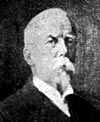
THOMAS EARP, (1830-1910), Maltster, Newark, took an active part in local and national affairs. He was Mayor of Newark in 1869, and twice afterwards, and in 1902, having been a member of the Town Council forty years, was presented with his portrait. He became M.P. for Newark, and was an Alderman of the County Council, and J.P. for both town and county. He gave a valuable site of ten acres for the building of the new Magnus Grammar School, and many other benefactions, amounting in the whole to £10,000.
WILLIAM WINDLEY, (1821-1877), Silk Manufacturer, Nottingham, built as a memorial to his father, Thomas Windley, Silk Dyer in Finkhill Street, the Church of All Saints' in Ealeigh Street, which has a tower and spire rising to one hundred and fifty-four feet, with a peal of bells, together with the vicarage, the parish hall, the parochial schools, the verger's house, etc. He vested the patronage in Trustees, the income of the living being £480 per annum. His beneficent gift cannot have been less than £25,000. The first vicar was the Rev. E. Gyles, M.A., a born teacher, great in the exposition of the Scriptures. The memory of his sermons remained with his parishioners for a generation.
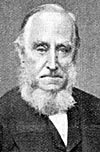
WILLIAM VICKERS, (1797-1882), was a Lace Manufacturer carrying on business in Weekday Cross, Nottingham, occupying the warehouse with an overhanging colonnade, the site being where the tanners in the olden time laid up their leather. He was bom at Mansfield, and sent to work at seven, but by self effort he became a well educated man. He taught in George Street Sunday School, and was one of the teachers who walked to Arnold and back on Sundays, and established and instructed a school of two hundred children. At twenty-one he was in business in the firm of Frearson & Vickers, then producing the finest specimens of lace.
He married Miss Mary Rogers, one of a family of seventeen; her father was the eldest of twenty-four, and her brother, Alderman Rogers, had fourteen children. Mr. Vickers was, in 1835, elected one of the first members of the new Corporation, in three years became an Alderman, and in 1843, when Queen Victoria was to pass through the town, he was made Mayor, and received the Queen and Prince Albert, who opened Queen's Road. He was the chairman of the Board of Guardians who determined in face of bitter opposition to build a new workhouse with garden land, to replace one that may be described as a den, excessively crowded, filthy, and unclassified. When Chairman of the Charitable Trustees he devoted much time to the removal of the Grammar School from Stoney Street to the new building in Arboretum Street. As Chairman of the Bridge Committee he promoted steps to the building of a new Trent Bridge. He was an active magistrate. For many years Superintendent of the George Street Boys' Sunday School, he was one of those who joined in building Derby Road Chapel, of which he was a deacon.
He was great grandfather of Captain Vickers who in 1916 won the Victoria Cross.
THOMAS RAWSTON STAREY, (1819-1891), was a Coach-builder in Nottingham, and after 1861 resided at Daybrook. He was born at Croydon Palace, where the Stareys had lived two hundred years. He was one of the first three officers who in 1859 joined the Robin Hoods, of which he became a Captain, Mr. (afterwards the Bt. Hon.) A. J. Mundella being for a time his Lieutenant. At a meeting of the most influential gentlemen in the town, held in the Mayor's Parlour, in 1867, he gave a lucid explanation of the Public Libraries Act, and afterwards in the Town Council proposed that a meeting of the ratepayers be called for the adoption of the Act, which was done and approved, and the Council appointed him Chairman of the Libraries Committee, in which capacity he acted for some years.
He was Chairman of the Sacred Harmonic Society, and two of his daughters were skilled violinists, and played in that Society's concerts, and in the Orchestral Society. He was on the first Committee of the Royal College of Music. He was President of the Bromley House Library, 1877-1879, and one of its Trustees. He actively promoted the Exhibition of Works of Art at the Castle Museum in 1878. He was J.P. of the Borough, courtly in manner and amiable in disposition.
EDWARD GRIPPER, (1815-1894), must have the credit of the modern development of brick-making in Nottingham. He was born at Layer Breton Hall, near Kelvedon, Essex, and after receiving a good commercial education he became an Essex farmer, and so continued until he was over forty, when he removed to Nottingham, and took charge of the Mapperley top brickyard and introduced brick-making by machinery. There had been small brickyards and kilns for two hundred years, especially on the South Eastern side of Woodborough Road, but a great development took place when, about 1866, Mr. Gripper with others, negotiated for the exclusive local use of Hoffman's continuous burning kilns, whereby the surplus heat after burning passed on to the next chamber so that the kiln never went out. He then entered into a partnership with Mr. Burgass, and formed the Patent Brick Company, a licence having been given to Mr. Loverseed. The Builders' Brick Company was formed about a year afterwards. The first kiln of the Patent Company was inaugurated by the Mayor attending a Lunch in the kiln, Mr. Robert Mellors, the Chairman of the Company, presiding. Not only was the burning of bricks altered, but the forming of them caused machines to be used, each costing £1,000, and when these were superseded—being the "semi-dry" process—plastic wire-cuts were made.
When Basford parish was annexed to Nottingham, Mr. Gripper was made an Alderman and J.P., and Chairman of the Water Committee, whose works were then largely extended. He was Mayor in the year of the opening of the University College, 1880-1, by H.R.H. the Duke of Albany. For sixteen years he was a member of the School Board, and Chairman thirteen years, during which period twenty sets of schools were built, and five or six others were transferred on extension. He devoted six hours a day to public business, and, being a man of great ability in grasping details, unwearied in labour, inflexibly just, and with a high sense of public duty, he rendered valuable service to the community.
The Company formed by Mr. Gripper and others, supplied a public want and reached an output in one year of over twenty-seven million bricks. It sent many best bricks to London for the building of St. Pancras Station, and to the London County Council, and contractors, and it established a reputation causing them to be described in specifications as a standard. Its directors promoted the construction of the Nottingham Suburban Railway, hoping thereby not only to benefit their trade but also to develop the North-eastern side of the City, but tramways shortly afterwards followed and took the passenger traffic. Fluctuating periods of briskness and depression in building followed. Then came the Land Valuation and Taxation legislation of 1909-10, believed to be aimed at the dukes, but-in-result it killed the speculating builder, and dispersed his workmen, and house building almost entirely ceased. The Great War followed, with Government interference, restrictions, and inflation of prices. Locally there was a scheme of demolishing insanitary houses, and wasteful and costly Government Housing Schemes followed; and after ten years of an abnormal state of affairs there is a terrible deficit in housing accommodation, resulting in much overcrowding and domestic inconvenience. The dawn of a better state of affairs is beginning to appear.
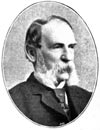
William Lambert.
JOHN and WILLIAM LAMBERT, Lace Dressers, in 1865 built the Theatre Royal, in Parliament Street, Nottingham, in order to supersede an unsuitable building in St. Mary's Gate, built about one hundred years before, and leased by a company of comedians, who visited the town three or four times a year, particularly at the races and Goose Fair. They could not gain by the building, but probably involved themselves in considerable loss, yet it was public-spirited on their part.
They gave the East window in St. Matthew's Church, and John gave the charming window in the North transept, representing the angel announcing to the Virgin the birth of a Son.
William Lambert became an Alderman, and as Chairman of the Public Parks Committee in 1898-1901, devoted much time to the construction of the Victoria or Trent Embankment, between the two bridges, involving and including the dredging of the Trent, and the formation of the pleasure and recreation roads and grounds; the total cost being over one hundred thousand pounds, including land. He died in 1905, aged 82.
Mr. Arthur Brown, the Corporation Engineer carried out this work, and it was one of the greatest pleasures to him in after life that he had thus had the opportunity of promoting the public good.
JOHN BARBER, (1813-1907), was a Grocer, in Nottingham. He was fifty-four years a member of the Town and City Council, and served the office of Sheriff (1847) and later Alderman, J.P., and Mayor, 1867-8. On behalf of the Corporation he negotiated with the County Magistrates for a mutual separation of the Town interest in the Sneinton Asylum, and arranged for the building of a new one at Mapperley. He was chairman of the Gas Committee, having negotiated the transfer from the old company to the town; Chairman of the Stoke Farm Sewage Scheme, and of the Committee for building the Guildhall, and Trustee of the General Hospital. When he had been fifty years on the Council his portrait was presented to him, being paid for by subscriptions, and it hangs in the Guildhall. The Freedom of the City was also presented to him.
WILLIAM LEE, (1841-1908), was an engineer, tool merchant, and valuer, in Nottingham, and was a lineal descendant from the Rev. William Lee, the inventor of the stocking frame. He was apprenticed to an engineer and foundry owner in Mansfield. When thirty years of age he commenced business with Mr. William Hunt. In commercial matters he was regarded as a man of sound judgment, with energy and integrity. He took an active part in the building of Queen's Walk Congregational Church, where for thirty years he was its mainstay, and being Superintendent of the Sunday School for twenty years he attended twice on a Sunday. He was President of the Notts. Congregational Union, the Sunday School Union, and the Band of Hope Union.
For eleven years he was a member of the Town Council, but leading the forces against the Council annually appointing a Race Committee, he at the next election lost his seat by ten votes. He was then made a Justice of the Peace, and became one of the first members of the West Bridgford Urban District Council. He was fond of fishing, had a keen sense of dry humour, and a high conception of public duty.
SAMUEL BOURNE, (1834-1912), resided in Nottingham Park. He built Cotton Doubling works at Netherfield, giving employment to several hundred people. He came to Nottingham as a clerk in Messrs. Moore & Robinson's Bank. He had a keen sense of the beautiful in nature, studied photography, and spent several years in India, and took a photographic journey through the Higher Himalayan mountains of exquisite beauty, and returning, the views were published by Marion & Co., and a pamphlet was printed for private circulation. He was President of the Nottingham Society of Artists, and gave attention to water colour painting. He took an active part in the advancement of High Pavement Chapel. He was a Justice of the Peace for both City and County. "The Love of Nature " is a beautiful "fragment" by him, and here is one verse of a hymn in "God is a Spirit,"
"The springs of Life their fountains have in Thee, Death is not, cannot be, for Thou dost live Immortal as Thyself Thy sons shall be, One endless life, Great Spirit, Thou dost give."
Mrs. Bourne did not long survive her husband, passing away the year following. Her life was made up of—
"A thousand little unrecorded acts of Kindness and of Love."
HENRY JOHN PEARSON, (1850-1913), of Beeston and Brameote. He and his brother, now Sir Louis F. Pearson, established the business of the Beeston Foundry Company, Ltd., and by his skill and energy largely extended its operations. He was an ardent student of bird life, possessed one of the finest collections of Arctic birds and eggs, and wrote several books thereon. He was a Fellow of the Royal Geographical Society; the British Ornithological Society, the Royal Horticultural Society, etc. He was on the Committees of the Nottingham Convalescent Homes, the Hospital for Women, etc., and rendered useful service thereori. He gave £1,000 towards the fund for the establishment of the Beeston Recreation Ground. He died in Egypt, and after a year and a day the body was brought and interred in Attenborough Church-yard.
STEPHEN HETLEY PEARSON, (1882-1917), a son of the before-named, in 1909 formed the 17th Nottingham Company of the Boys' Brigade, of which he was Captain, and thenceforth devoted all his leisure time to the welfare of the boys. Largely at his own cost, and that of his mother and other members of the family, together with the contributions of the boys and their parents, he built spacious premises for the corps and a Lads Club, one of the most complete equipments in the Country, and having its Bible and educational evening classes, and recreation field. During the Great War he joined as a private the Northumberland Fusiliers, and obtained a commission in the Grenadier Guards, and was killed at Cambrai. He had vested the Club premises in Trustees, and with a Committee of Management, and an endowment of £10,000.
RICHARD FITZHUGH, (1833-1918), J.P., Nottingham, was a chemist's assistant, and by dint of energy and perseverance he became proprietor of the business No. 21, Long Row. He was a Town Councillor eighteen years, during ten of which he was Chairman of the Watch Committee. He was Mayor in 1891. After retiring from the Council some years he had the honour of being elected an Alderman, although not a member of the Council, a course that might with public advantage be more frequently followed. He was President of the Nottingham Chemists Association for 50 years, and was one of the originators of the evening classes for pharmacy students at the University College. He was President of the Savings Bank, and the Dispensary; a Director of the Nottingham & Notts. Bank; and was a prominent Freemason. His kindness of heart and suavity of manner caused him to have many friends.
JAMES GRANGER, (1827-1918), was a Joiner on Derby Road, Nottingham, but he was more. He was present at the inaugural meeting of the Nottingham Mechanics' Institution in 1837, when he became a member, was elected on the committee in 1851, and with brief intervals continued actively to work in an official capacity for over sixty years. He was made a Trustee, and Vice-President of the Institution, and in his eighty-fifth year wrote a "Retrospect" of the operations of the Institution from its commencement, occupying 24 pages of a pamphlet which the committee published in 1912, when the number of members was over 4,500 and the books in the Library were 35,000 with 170,000 issues.
Mr. Granger had an unique knowledge of the old streets in Nottingham, and of the changes that have during the past century taken place in regard thereto, and when he became infirm his pastime was to trace the changes, and give a history of them. In this way he for some years wrote interesting notes to the local papers, and published books, and wrote articles in the Transactions of the Thoroton Society, recording much of interest that was unknown, or had been forgotten.
He continued to the great age of ninety-one, occupied as had been the habit and pleasure of his life, in being of some service to his fellows.
WILLIAM J. JESSOP, (d. 1919), silk mercer and draper, who built the large premises on the East of King Street, Nottingham, set an example of interest in the welfare of his workwomen by purchasing and fitting up "The Hermitage," in the Park, as a residence for what are called indoor-workers. The house is modern, but has historical and interesting associations, for the grounds contain the caves in the rock cliff, formerly much more extensive and known as "St. Mary-le-rocks," being a cell connected with the Priory of Lenton. The present occupation of "The Hermitage" does not debar Church and Benevolent Societies from having, by permission, its occasional festival use.
By his will Mr. Jessop bequeathed the King Street premises to the Nottingham Church Extension Fund, who lease the premises to the Company now carrying on the business.
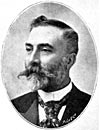
SIR FRANK BOWDEN, (1848-1921), Bart., J.P., after a business career in China, which seriously injured his health, and finding that benefit was derived from cycling, he resolved to devote himself to the production of cycles, and eventually he built cycle manufacturing works at Lenton, which with additions erected after his death, are capable of employing five thousand persons, thereby very largely extending the manufacture of various articles. In the Great War fuses were being made. Under his will there were bequests to several Institutions. Among the bequests was a collection of Oriental arms and armour to the City of Nottingham, including eight complete suits of armour, which serve to illustrate the trappings of a Japanese warrior, some of them being of ancient make, and with the reputation of having supernatural powers, having lavish adornments.
EDWIN WILMHURST, (1833-1922), was an ironmonger and bar iron merchant, at Retford, but he was much more, and it is worth recording that in the same business concern he continued fifty years, in the capacities of apprentice, assistant, partner, sole proprietor, then he afterwards admitted a partner, in whose favour he ultimately retired. He was of a literary turn, and served as honorary secretary to a Literary Society and Library. He wrote articles for the London magazines and local press, as well as published several pamphlets. He was Treasurer of the Retford Hospital. He was musical and became Treasurer of the Choral Society, and aided the Amateur Dramatic Society. He was fond of travel on the continent, and went to the Holy Land. In church work he was diligent, being a Sunday School teacher thirty-seven years, a member of the Church choir from 1890, and churchwarden twenty-seven years. It was, however, as Bailyffe, or agent, for the "Hospital of the Holy and Undivided Trinity in West Retford" that he will be chiefly remembered, for by unwearied attention and careful management the estates were improved, the income and benefits increased, and the public convenience greatly promoted. The construction of the Victoria Road (that is the road direct from the Great Northern Railway Station to the Market Place) through the estate and chiefly at its cost, he steadily pursued against much opposition and discouragement until it was accomplished. (Retford Times). (See article on John Darrel).
SIR JAMES RECKITT, Bart., (1833-1924), J.P., D.L., of Swanland Manor, Hull, Chairman of Reckitt & Sons, Ltd., Ball Blue and Starch manufacturers, the son of Isaac Reckitt, was born in Nottingham, where the family then resided. His father in 1840 removed to Hull, and commenced business in a very small way, but to-day the works of the firm cover several acres, with 2,000 to 3,000 workpeople, with works in Australia, America, and on the Continent. A distinguished member of the Society of Friends, it is as Hull's greatest benefactor that Sir James will be remembered. One of his most notable gifts was a garden city, or model village, for Hull, which cost him £140,000. He established in 1893 a Free Library, at a cost of £5,000, called the James Reckitt Library, in connection with which he received his baronetcy. In 1915 he and Lady Reckitt celebrated their golden wedding, when many gifts were made, it was said amounting to £25,000. An Orphanage, a Convalescent Home, a new wing to the Royal Infirmary, were among the objects of his beneficence. For his workpeople he instituted a liberal system of pensions. He was connected with all kinds of religious, social, educational and administrative offices and movements. Locally he was a Director of the Wollaton Colliery Company, Limited.
L. Collins, J. Fellows, R. Mellers,
See "Families."
SKILLED WORKMEN should follow "Manufacturers," for skilled work is of great importance in every trade, not merely to the parties immediately concerned, but the welfare of the entire district is enhanced thereby, and the men who specially distinguish themselves by their skill in continuous work, and by their helpfulness to others, deserve not merely higher wages but should in some form be recognised as in a kind of "Legion of Honour," but I do not know where to look for such register, and therefore am unable to give examples.
< Previous | Contents | Next >
* "Fifty Years of Public Work," Vol. I. pp. 354-5-6.
